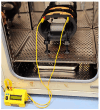The Frequency of a Magnetic Field Determines the Behavior of Tumor and Non-Tumor Nerve Cell Models
- PMID: 40076656
- PMCID: PMC11899782
- DOI: 10.3390/ijms26052032
The Frequency of a Magnetic Field Determines the Behavior of Tumor and Non-Tumor Nerve Cell Models
Abstract
The involvement of magnetic fields in basic cellular processes has been studied for years. Most studies focus their results on a single frequency and intensity. Intensity has long been the central parameter in hypotheses of interaction between cells and magnetic fields; however, frequency has always played a secondary role. The main objective of this study was to obtain a specific frequency that allows a reduction in the viability and proliferation of glioblastoma (CT2A) and neuroblastoma (N2A) cell models. These were compared with an astrocyte cell model (C8D1A) (nontumor) to determine whether there is a specific frequency of response for each of the cell lines used. The CT2A, C8D1A, and N2A cell lines were exposed to a magnetic field of 100 µT and a variable frequency range between 20 and 100 Hz for 24, 48 and 72 h. The results fit a biological window model in which the viability and proliferation of N2A and CT2A cells decrease statistically significantly in a 50 Hz center of value window. In addition, the non-tumor cell model showed different behavior from tumor cell models depending on the applied frequency. These results are promising in the use of magnetic fields for therapeutic purposes.
Keywords: astrocytes; biological window; frequency; glioblastoma; magnetic field; neuroblastoma; proliferation; viability.
Conflict of interest statement
The authors declare no conflicts of interest.
Figures




Similar articles
-
The Frequency of a Magnetic Field Reduces the Viability and Proliferation of Numerous Tumor Cell Lines.Biomolecules. 2025 Mar 31;15(4):503. doi: 10.3390/biom15040503. Biomolecules. 2025. PMID: 40305213 Free PMC article.
-
50 Hz magnetic field influences caspase-3 activity and cell cycle distribution in ionizing radiation exposed SH-SY5Y neuroblastoma cells.Int J Radiat Biol. 2024;100(8):1183-1192. doi: 10.1080/09553002.2024.2369105. Epub 2024 Jun 26. Int J Radiat Biol. 2024. PMID: 38924721
-
The antitumor effect of static and extremely low frequency magnetic fields against nephroblastoma and neuroblastoma.Bioelectromagnetics. 2018 Jul;39(5):375-385. doi: 10.1002/bem.22124. Epub 2018 May 2. Bioelectromagnetics. 2018. PMID: 29719057
-
30 Hz, Could It Be Part of a Window Frequency for Cellular Response?Int J Mol Sci. 2021 Mar 31;22(7):3642. doi: 10.3390/ijms22073642. Int J Mol Sci. 2021. PMID: 33807400 Free PMC article. Review.
-
Comet assay in neural cells as a tool to monitor DNA damage induced by chemical or physical factors relevant to environmental and occupational exposure.Mutat Res Genet Toxicol Environ Mutagen. 2019 Sep;845:402990. doi: 10.1016/j.mrgentox.2018.11.014. Epub 2018 Nov 30. Mutat Res Genet Toxicol Environ Mutagen. 2019. PMID: 31561896 Review.
Cited by
-
The Frequency of a Magnetic Field Reduces the Viability and Proliferation of Numerous Tumor Cell Lines.Biomolecules. 2025 Mar 31;15(4):503. doi: 10.3390/biom15040503. Biomolecules. 2025. PMID: 40305213 Free PMC article.
References
MeSH terms
Grants and funding
LinkOut - more resources
Full Text Sources

